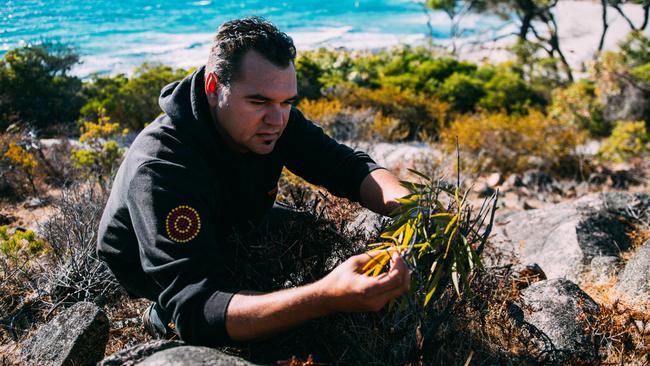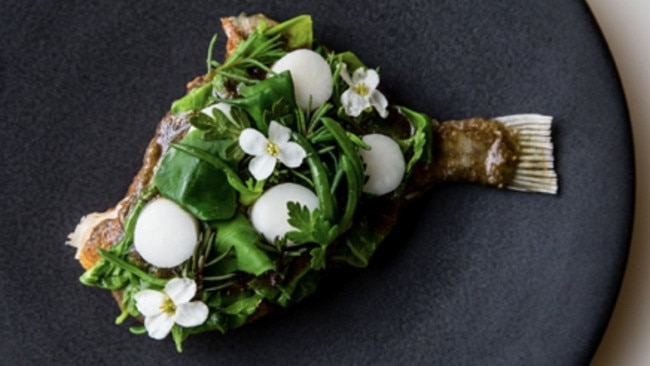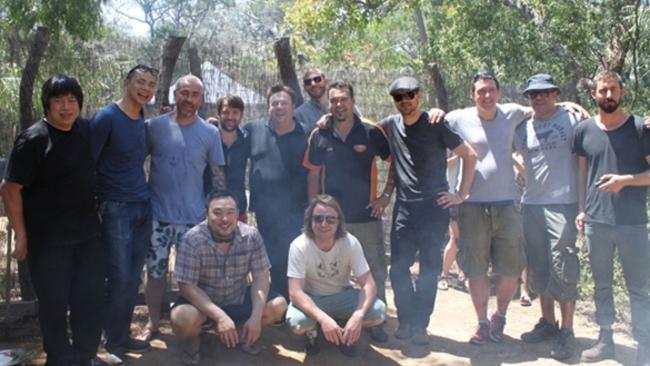The native chefs using local bush tucker
An outing with Josh Whiteland to forage for local indigenous foodstuffs went on to inspire top international chefs.

He moves across the unforgiving, rocky coastal headland with a kind of animal grace, a man in his element. “Down there, between the rocks,” says Josh Whiteland, “that’s where the seeds settle. That’s where the sea celery grows best.”
Indeed, sea celery is one of those foraged coastal plants modern diners have now come to take for granted, a fixture in restaurants from Quay to Orana and many points between. As is saltbush, another ingredient you’ll find on just about every progressive menu throughout the nation. There’s samphire, too, “native apricot” and coastal fig.
We’re clambering around the headland at Meelup, west of Dunsborough in the south west of Western Australia, a beautiful part of the country three hours southwest of Perth, popular with holiday-makers for its calm beaches, unspoilt landscape and exceptional water, teeming with sea life.
It’s a place I know well; I’ve swum here, sailed, fished, basked in the summer sun. Speared the odd squid. What’s different today is that I see this rugged coast through Whiteland’s eyes. And what I see, for the first time, is food.
Whiteland’s business is Koomal Dreaming; it may be best described as a cultural bridging enterprise. A Wardandi man, whose clan are the original inhabitants of this corner of the West, Whiteland has turned many a curious visitor on to the native foodstuffs of this region that have sustained his people for 50,000 years. Foodstuffs that are not readily identified by the Western eye: grasses, fruits, ground covers, saps, tubers.
But it was a particular group, nearly five years ago, that just may have helped Whiteland write a small but significant chapter in Australian, if not international, culinary history.
Picture the scene. It’s the first Margaret River Gourmet Escape, November 2012 and some stellar identities have been cajoled to participate in this now-annual major food festival. Adelaide chef Jock Zonfrillo, who has done more than any other in Australia to integrate indigenous foods into a modernist cuisine, gets an 11th-hour call asking him to put together some kind of event for the stars that “is more in connection with the land, a welcome to country”. He calls Whiteland. And that event, it may be argued, was a light bulb moment for some highly influential chefs.
One of the country’s best-known chefs, Peter Gilmore from Sydney’s Quay and Bennelong restaurants, recalls the event.

“My eyes were opened to the possibilities of Australia’s unique flora when I attended the first Margaret River Gourmet Escape,” the chef writes in his book Organum. “I was taken on a tour by an Aboriginal leader named Josh Whiteland from Wardandi country in WA near Margaret River. He explained to a group of chefs — including Alex Atala, Rene Redzepi and David Chang — about the local native food sources of his region.
“He told us how the Wardandi people had always divided the year into six distinct seasons and how the seasons were identified by the natural cycle of animals and plants. A given season occurs when a certain fish is spawning or when a particular tree is in flower. This experience illustrated to me how much I didn’t know about native Australian edible flora.”
It was, in culinary terms, a heavy crowd.
Among them were Alvin Leung of Bo Innovation in Hong Kong; Andre Chiang of Singapore’s two Michelin star Restaurant Andre; Chang, the man behind the Momofuku empire; Atala from Sao Paulo, whose D.O.M. is always ranked among the world’s “best” by the World’s 50 Best list; Redzepi, possibly the most influential chef of the century, and his then head chef Daniel Giusti, from Copenhagen; Gilmore and Justin North, both highly influential chefs in Sydney; Australians David Moyle and Matt Wilkinson, both highly respected; Sat Bains, the two Michelin star Brit from Nottingham; Zonfrillo, of course. And British journalist and critic AA Gill.
Whiteland reflects on that day of foraging, cooking and eating with some of the most famous chefs in the world.
“To be honest, I was surprised how few of them knew anything about it at all,” he says. “For me, this is what we’ve always done in my family.”
“This” was sourcing a meal from the land and the sea. Along with the foraged and hunted wild foods — kangaroo, emu, abalone and squid among them — it was for most an introduction to the indigenous Australian concept of six seasons: each of the six seasons represents and explains seasonal changes we see annually. The flowering of many different plants, the hibernation of reptiles and the moulting of swans are all helpful indicators that the seasons are changing.
Seasons can be long or short and are indicated not by dates on a calendar but by what is happening and changing around us.

According to Gilmore, several factors converged around that time in history that led to what is now the broadscale use of certain indigenous ingredients — among them quandongs, warrigal greens, saltbush, paperbark and finger lime — by restaurant chefs.
A key factor was the progressive supply of many indigenous flora via the company Outback Pride, he says.
Gayle Quarmby and her horticulturalist husband Mike run Outback Pride from their property in rural South Australia.
Their Reedy Creek Nursery has become Australia’s largest producer of indigenous plants, fruits and vegetables, supplying hundreds of chefs around the country. Their impact has been significant.
Another was the greater availability of certain meats, in particular wallaby from Flinders Island.
The other, says Gilmore, was his experience with Whiteland, who took the group to a place near Yallingup, the famous surf beach, and breaking open a grass tree, eating the heart of the plant and the tips of the brittle grass blades, a source of both nutrition and moisture in dry spells.
“It honestly blew my mind that this was something people ate,” he says now, and whether it’s Quay or Bennelong, there will always be subtle melding of indigenous ingredients now in one or more of his dishes.
So impressed by the experience was Redzepi that, in 2013 for MAD, his annual left-of-centre food symposium, the Dane brought Whiteland to Copenhagen to speak about Australian indigenous foods. Attendees came from all over the world to hear the likes of Alain Ducasse speak to the subject of “Guts”.
Momofuku founder Chang says the day had a big personal impact on him.
“By no means in late 2012 was I an expert in native ingredients, particularly of Western Australia. But as a team we were familiar with many of those ingredients. What Josh did was put the raw foodstuffs in a cultural context that allowed us to better appreciate what we were cooking.
“I know this was personally the case for me.”
In that five years, via a series of developments including Whiteland’s 2012 session, indigenous ingredients have moved from novelty to mainstream, no longer something needing constant explanation. Chefs such as Kylie Kwong, Ben Shewry, Dan Hunter, Jed Gerrard, Zonfrillo and Gilmore have led by example, and the trickle-down has been palpable.
“I guess by that stage I was about a decade into it,” says Zonfrillo, of Adelaide’s Orana, whose fascination with indigenous culture and foods is well documented.
“For me it was without doubt a moment when there was some kind of recognition among my peers, where everyone else got it and it wasn’t just me banging on about it. It was an affirmation, I suppose.”
Zonfrillo says it’s no stretch to suggest the Margaret River event triggered in Redzepi a fascination for Australia’s native bounty that ultimately led to the Sydney Noma pop-up in 2016 where a vast array of indigenous ingredients were employed.
Adventurous chefs have been using finger lime, for example, for decades, but the popularity sparked by Noma took the bush fruit to a whole new level across the nation, a moment when true crossover was achieved.
Back in Yallingup just last month, Whiteland stops the car and points out a patch of Geraldton wax, the young tips of which produce a harmonious citrus-like fragrance and sourness.
“Perfect for fish,” he says.
Indeed, as it subsequently transpires over a lunch of kangaroo, crocodile, emu, quandong chutney, bread with lemon myrtle butter and squid, the Geraldton wax is extremely good with an underrated catfish-like inner coastal species known locally as cobbler, Cnidoglanis macrocephalus.
“That area out there” — he points to the native bush — “it’s like a giant supermarket.”
John Lethlean was a guest in Yallingup of Tourism Western Australia. Margaret River Gourmet Escape 2017 runs November 16-19, with tickets on sale July 28.

To join the conversation, please log in. Don't have an account? Register
Join the conversation, you are commenting as Logout